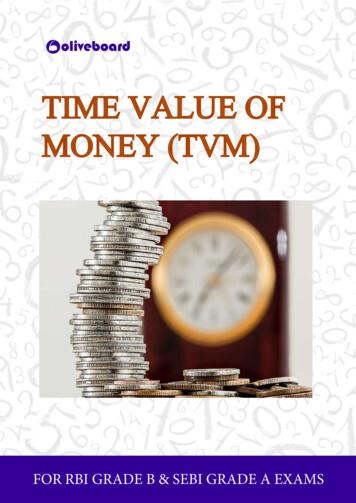
Transcription
TIME VALUE OFMONEY (TVM)FOR RBI GRADE B & SEBI GRADE A EXAMS
Time Value of MoneyFree Finance e-bookTime value of money is central to the concept of finance. And this topic is crucial for theFinance part asked in RBI Grade B & SEBI Grade A Exams. Let us learn it in detail here in thiseBook.Time Value of Money (TVM)Time value of money (TVM) is the idea that money that is available at the present time isworth more than the same amount in the future, due to its potential earning capacity. Thiscore principle of finance holds that provided money can earn interest, any amount of moneyis worth more the sooner it is received.In simpler terms, it would be safe to say that a Rupee was worth more yesterday than todayand a Rupee today is worth more than a Rupee tomorrow.InterestInterest can be a charge or an income, depending on whether you are borrowing money orlending/investing money. It is stated as a percentage over a specific period of time.There are many types and forms of interest.Simple InterestSimple interest is computed on the original amount as the return on that principal for onetime period.SI P R TwhereSI Simple InterestP Amount borrowed (called "Principal")R Interest rateT timeAmount Principal SI
Time Value of MoneyFree Finance e-bookExample: Rs 1,000 invested for 10 years at 5% simple interest will yield Rs 1,500 by the end often years.Amount 1000 (1,000 x 0.05 x10) Rs 1,500.For instance, if one were to receive 5% interest on a beginning value of Rs100, the first-yearinterest would be:Rs 100 0.05 Rs 5 in InterestContinuing to receive 5% interest on the original Rs 100 amount, over five years the growthof the original investment would look like:Year 1:Year 2:Year 3:Year 4:Year 5:5% of Rs 100 Rs 5 Rs 100 Rs 1055% of Rs 100 Rs 5 Rs 105 Rs 1105% of Rs 100 Rs 5 Rs 110 Rs 1155% of Rs 100 Rs 5 Rs 115 Rs 1205% of Rs 100 Rs 5 Rs 120 Rs 125Compound InterestCompound interest is computed on the original amount as the return on that principal plusall unpaid interest accumulated to date.Compound interest is always assumed in TVM problems.CI [P (1 R) n] – PCI P [(1 R) n – 1]For instance, if one were to receive 5% compound interest on a beginning value of Rs 100, thefirst-year interest would be the same as simple interest on the Rs100,Rs 105 .05 Rs 5.25 in InterestThis provides a balance at the end of year two of Rs 110.25. If this were to continue for 5years, the growth in the investment would look like:Year 1:Year 2:Year 3:Year 4:Year 5:5% of Rs 100.00 Rs 5.00 Rs 100.00 Rs 105.005% of Rs 105.00 Rs 5.25 Rs 105.00 Rs 110.255% of Rs 110.25 Rs 5.51 Rs 110.25 Rs 115.765% of Rs 115.76 Rs 5.79 Rs 115.76 Rs 121.555% of Rs 121.55 Rs 6.08 Rs 121.55 Rs 127.63
Time Value of MoneyFree Finance e-bookThis is a powerful concept that means money can grow at an exponential rate depending onhow often interest is credited to the account. Once interest is credited, it becomes in effectprincipal.Instead of calculating interest year-by-year, it would be simple to see the future value of aninvestment using a compound interest formula.The formula for compound interest is:Pn P0(1 i) n Pn value at end of n time periodsP0 beginning valuei interestn number of periodsFor example, if one were to receive 5% compounded interest on 100 for five years, to usethe formula, simply plug in the appropriate values and calculate.Pn Rs 100(1.05)5 Rs 127.63Fixed Interest RateFixed interest rate is a straightforward rate that remains constant during the life of the loanor investment.Variable Interest RateVariable interest rate changes during the life of the loan and is usually tied to the prime rate.It can go up or down depending on the prime rate set forth by the Central banks of a country.Mixed Interest RateMixed interest rate changes from fixed to variable or from variable to fixed. It has some meritsdepending on your situation, but it is not a rate you would want to choose for a long-terminvestment or debt.
Time Value of MoneyFree Finance e-bookTime Value and Purchasing PowerThe time value of money is also related to the concepts of inflation and purchasing power.Both factors need to be taken into consideration along with whatever rate of return may berealized by investing the money.Inflation and purchasing power must be factored in when you invest money because tocalculate your real return on an investment, you must subtract the rate of inflation fromwhatever percentage return you earn on your money.If the rate of inflation is actually higher than the rate of your investment return, then eventhough your investment shows a nominal positive return, you are actually losing money interms of purchasing power.For example, if you earn a 10% on investments, but the rate of inflation is 15%, you areactually losing 5% in purchasing power each year (10% – 15% -5%).Time Value of Money FormulaA specific formula can be used for calculating the future value of money so that it can becompared to the present value:Where:FV the future value of moneyPV the present valuei the interest rate or other return that can be earned on the moneyt the number of years to take into considerationn the number of compounding periods of interest per yearPresent Value of Future Money FormulaThe formula can also be used to calculate the present value of money to be received in thefuture.
Time Value of MoneyFree Finance e-bookAnnuityAn annuity is an equal, annual series of cash flows.When cash flows occur at the end of the year, this makes them an ordinary annuity. If thecash flows were at the beginning of the year, they would be an annuity due.Annuities work as follows:Annuity Equal Annual Series of Cash Flows.Assume annual deposits of Rs100 deposited at end of year earning 5% interest for threeyears.Year 1: Rs 100 deposited at end of year Rs 100.00Year 2: Rs 100 .05 Rs 5.00 Rs 100 Rs 100 Rs 205.00Year 3: Rs 205 .05 Rs 10.25 Rs 205 Rs 100 Rs 315.25The primary types of annuities are:1. Fixed AnnuitiesAnnuities that provide fixed payments. The payments are guaranteed, but the rate of returnis usually minimal.2. Variable AnnuitiesAnnuities that allow an individual to choose a selection of investments that will pay an incomebased on the performance of the selected investments. Variable annuities do not guaranteethe amount of income, but the rate of return is generally higher relative to fixed annuities.3. Life AnnuitiesLife annuities provide fixed payments to their holders until his/her death.4. PerpetuityAn annuity that provides perpetual cash flows with no end date. Examples of financialinstruments that grant perpetual cash flows to its holder are extremely rare.
Time Value of MoneyFree Finance e-bookValuation of AnnuitiesAnnuities are valued by discounting the future cash flows of the annuities and finding thepresent value of the cash flows.The general formula for annuity valuation is:Where:PV Present value of the annuityP Fixed paymentr Interest raten Total number of periods of annuity paymentsThe valuation of perpetuity is different because it does not include a specified end date.Therefore, the value of the perpetuity is found using the following formula:PV P / rWhat Is the Rule of 72?The Rule of 72 is a simple way to determine how long an investment will take to double givena fixed annual rate of interest. By dividing 72 by the annual rate of return, investors obtain arough estimate of how many years it will take for the initial investment to duplicate itself.How the Rule of 72 Works?For example, the Rule of 72 states that Rs 1 invested at an annual fixed interest rate of 10%would take 7.2 years ((72/10) 7.2) to grow to Rs 2.In reality, a 10% investment will take 7.3 years to double ((1.107.3 2).The Rule of 72 is reasonably accurate for low rates of return.
Time Value of MoneyFree Finance e-bookRule of 114One can use this method to estimate how much time it will take to triple the wealth. Hereyou have to divide 114 by interest rate to get in how many years your money gets tripled.Time for investment to triple 114/ %age Rate of ReturnGoing by the same example of mutual funds with an annual return of 14%, the time it isgoing to take to triple your money would be (114/ 14) 8.14 years.Rule of 144The final rule in line is the rule of 144. As evident, this rule tells how long it will take for yourmoney to become four times its original value or Quadruple. This rule is basically for peoplewho stay invested for a really long-term in order to see their money actually become fourtimes.The rule goes as:Time for investment to double 144 / %age Rate of ReturnFollowing the above example of a mutual fund with 14% annual return, the time it would takethe money to become four times is (144/14) 10.28 years.This is all from us in this eBook of Time Value of Money.Sources: wledge/finance/annuity/#: :text %20of%20annuity%20payments
FREE EbooksCurrent AffairsDownload NowExplore NowFREE MOCK TESTS TOPIC TESTS SECTIONAL TESTSFor Banking, Insurance, SSC & Railways ExamsWebAPPBLOGFORUMYour one-stop destinationfor all exam relatedinformation & preparationresources.Interact with peers & experts,exchange scores& improve your preparation.Explore NowExplore Nowwww.OliveBoard.in
Time Value of Money Free Finance e-book Time value of money is central to the concept of finance. And this topic is crucial for the Finance part asked in RBI Grade B & SEBI Grade A Exams. Let us learn it in detail here in this eBook. Time Value of Money (TVM) Time value of money (TVM) is the










